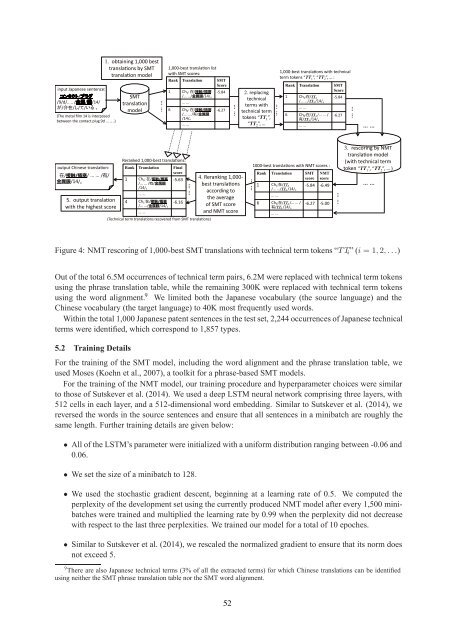December 11-16 2016 Osaka Japan
W16-46
W16-46
You also want an ePaper? Increase the reach of your titles
YUMPU automatically turns print PDFs into web optimized ePapers that Google loves.
Figure 4: NMT rescoring of 1,000-best SMT translations with technical term tokens “TT i ”(i =1, 2,...)<br />
Out of the total 6.5M occurrences of technical term pairs, 6.2M were replaced with technical term tokens<br />
using the phrase translation table, while the remaining 300K were replaced with technical term tokens<br />
using the word alignment. 9 We limited both the <strong>Japan</strong>ese vocabulary (the source language) and the<br />
Chinese vocabulary (the target language) to 40K most frequently used words.<br />
Within the total 1,000 <strong>Japan</strong>ese patent sentences in the test set, 2,244 occurrences of <strong>Japan</strong>ese technical<br />
terms were identified, which correspond to 1,857 types.<br />
5.2 Training Details<br />
For the training of the SMT model, including the word alignment and the phrase translation table, we<br />
used Moses (Koehn et al., 2007), a toolkit for a phrase-based SMT models.<br />
For the training of the NMT model, our training procedure and hyperparameter choices were similar<br />
to those of Sutskever et al. (2014). We used a deep LSTM neural network comprising three layers, with<br />
512 cells in each layer, and a 512-dimensional word embedding. Similar to Sutskever et al. (2014), we<br />
reversed the words in the source sentences and ensure that all sentences in a minibatch are roughly the<br />
same length. Further training details are given below:<br />
• All of the LSTM’s parameter were initialized with a uniform distribution ranging between -0.06 and<br />
0.06.<br />
• We set the size of a minibatch to 128.<br />
• We used the stochastic gradient descent, beginning at a learning rate of 0.5. We computed the<br />
perplexity of the development set using the currently produced NMT model after every 1,500 minibatches<br />
were trained and multiplied the learning rate by 0.99 when the perplexity did not decrease<br />
with respect to the last three perplexities. We trained our model for a total of 10 epoches.<br />
• Similar to Sutskever et al. (2014), we rescaled the normalized gradient to ensure that its norm does<br />
not exceed 5.<br />
9 There are also <strong>Japan</strong>ese technical terms (3% of all the extracted terms) for which Chinese translations can be identified<br />
using neither the SMT phrase translation table nor the SMT word alignment.<br />
52



